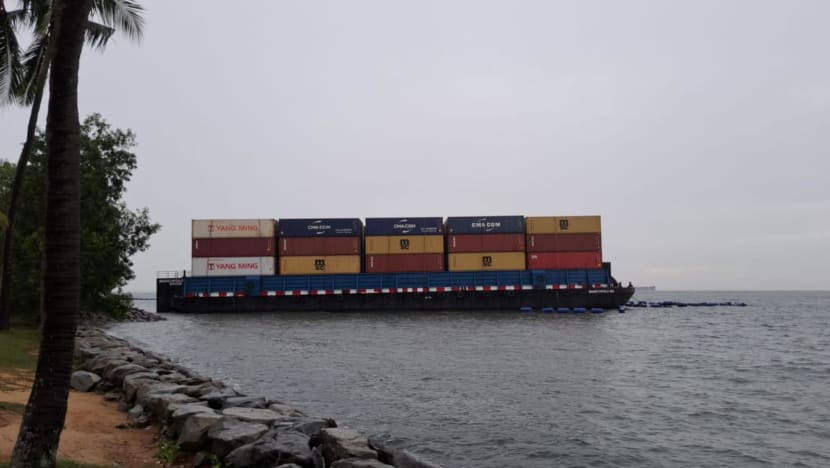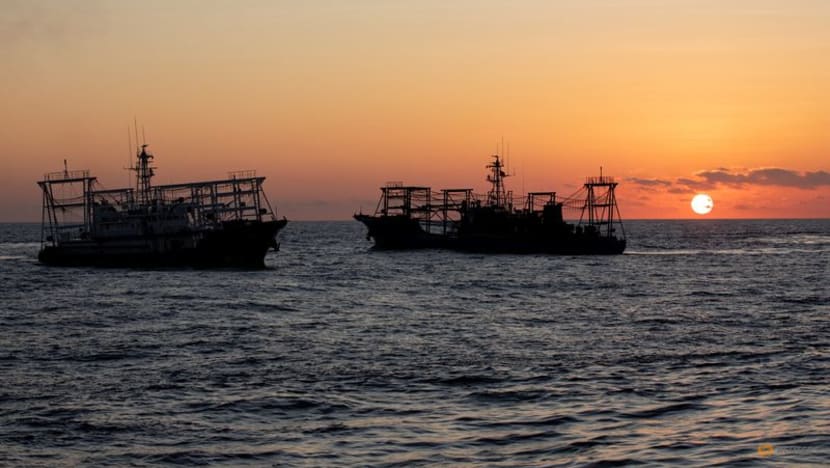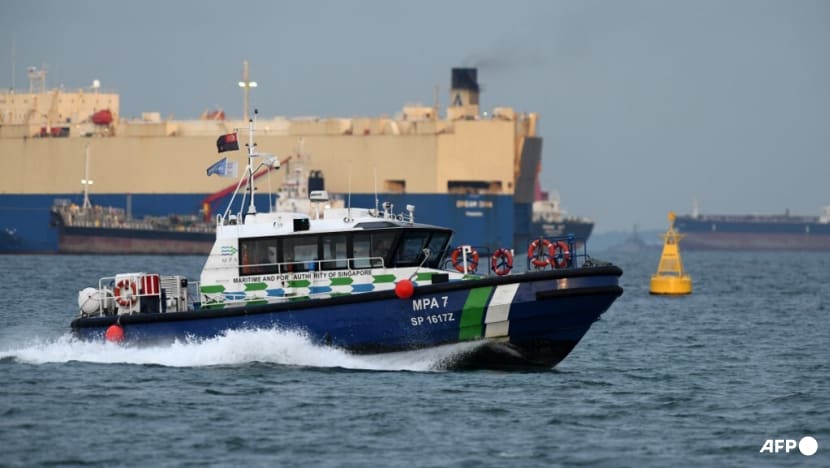Along Singapore's coastlines, evolving challenges from volatile currents to rogue actors
SINGAPORE: He was sailing through a channel between Sentosa and Lazarus islands south of Singapore, when his vessel met with strong winds and currents.
The captain soon noticed something was amiss with his ship’s position relative to a fixed navigation buoy, a sign that it was on the dangerous side of the channel.
The 35m-long vessel was in fact being pushed by the elements towards a hidden shoal off Lazarus, a popular destination for nature lovers and beach goers.
A quick intervention by the captain to divert the vessel sharply to the right helped avert disaster – barely.
“It was so close to hitting a shoal that couldn’t be seen due to high tide,” the now-retired captain Iskandar Ismail told CNA.
He added that his ship's alarms sounded metres away from the shallow waters, and that grounding and subsequent environmental pollution were real risks.
The close shave has served as a reminder to Mr Iskandar, who for five years sailed on bunker tankers among other vessels, of the challenges navigating Singapore’s coastal waters.
In June, a container barge ran aground off Tanjong Beach in Sentosa. There were no reports of damage, injuries or pollution, and the barge was later towed away for inspection and investigation.
Two years ago, a superyacht also ran aground near the Buran Channel near Sentosa.
“Ships losing control is not a new phenomenon, but thankfully still relatively rare,” said Mr Toby Stephens, head of shipping in Asia for global maritime law firm HFW.
It is nevertheless a concern in a busy port like Singapore, especially in the vicinity of areas like Jurong Island and liquified natural gas (LNG) terminals, he added.
Mr Stephens cited the example of the Vox Maxima incident in 2024 - Singapore's worst oil spill in a decade.
The Netherlands-flagged dredger lost steering control before colliding with the Singapore-flagged Marine Honour at Pasir Panjang Terminal in June last year, causing about 400 tonnes of oil to spill into the sea.
The oil washed up along Singapore’s southern shorelines, including beaches at Sentosa, East Coast Park and Labrador Nature Reserve. Clean-up operations took over two months.
Abroad, there have also been periodic cases of large vessels colliding into coastal infrastructure when passing through waterways.
Singapore-flagged container vessel Dali smashed into a Baltimore bridge in March last year, after losing power and despite desperate attempts to stop in time by dropping anchor.
In May, a Mexican Navy training ship Cuauhtemoc also lost power and slammed into the Brooklyn Bridge in New York.
ROGUE WAVES, ROGUE SHIPS
Challenges unique to manoeuvring through Singapore’s waters include strong tidal currents when entering narrow straits and channels, and heavy maritime traffic, industry players told CNA.
Singapore’s coastal infrastructure – from civilian structures like Marina Barrage and Bedok Jetty, to industrial facilities like those on Jurong Island – now faces greater risks with rising sea levels, changing climate and complicated tropical coastal geography, said coastal science professor Adam Switzer from the Nanyang Technological University's Asian School of the Environment and Earth Observatory of Singapore.
“Ocean currents, including in Singapore, are commonly fast, shifting and hard to predict. Extreme waves from storm activity, potential tsunamis and other rogue waves can hit with little warning. Runaway vessels may lose control in strong currents,” said the expert in coastal hazards.
The move to new fuels as a result of industry efforts to decarbonise may also increase short-term risks, as ships adjust to new technology and systems, noted Mr Stephens.

Increasing maritime congestion is another ongoing issue. Beyond the sheer number of ships, there is the added complexity of different sized vessels and multi-way traffic.
A ship captain who has sailed for about a decade, from ocean-going container ships to coastal vessels, told CNA that some ships are unfamiliar with Singapore’s waters and do not anticipate the number of vessels they would encounter.
He chose to remain unnamed as he is still working in the industry.
“Some ships are designed to run at fixed speeds for a very long time, so the engineers will adjust the settings as such,” he said.
Not expecting the high level of traffic, they do not lower their speeds before passing through, which is dangerous as it could take vessels up to 15 minutes to slow down, he said.
On the other hand, it is also dangerous if a ship moves too slowly as currents could push it sideways, noted the captain.
“Poor visibility during heavy downpours and strong winds also affect vessel manoeuvrability,” added Mr Iskandar.
Then there is the language barrier over radio communications, as some vessels carry crew with a poor command of English, he said.
Prof Switzer pointed to another threat in the form of rogue actors seeking to breach sea-facing oil terminals or industrial hubs.
“Due to recent global developments, Singapore should review the potential threats and take preventive and reactive action to enhance its security,” said S Rajaratnam School of International Studies security studies professor Rohan Gunaratna.
These include the conflict in the Middle East, the Ukraine-Russia war and the South China Sea dispute.

“It is generally not the well-run, well-regulated ships to worry about, but dark fleet or rogue ships, of which there is an increasing volume,” Mr Stephens added.
A “dark ship" is a vessel which employs illicit or evasive tactics to transport oil from countries subject to global sanctions.
WHAT'S BEING DONE ABOUT IT
The unnamed ship captain said he takes additional safety measures when his vessel nears Singapore’s shore and port.
This includes deploying crew to visually monitor the surroundings, beyond using radar and electronic charts.
Another measure is to ensure the vessel is ready to change its speed or direction on short notice, to respond to any situation.
Mr Stephens noted that for Singapore, there are “exclusion zones around all naval bases and critical infrastructure which minimises traffic and therefore also the risk of damage”.

“The east coast, in particular, is congested with ships at anchor, which provides a boundary for any ships that have loss of control, meaning they will likely hit other ships before reaching shore,” he said.
Mr Stephens also pointed to the Maritime and Port Authority of Singapore's (MPA) Vessel Traffic Information System, which constantly tracks new problems developing out on the waters and can call in tugboats to assist when needed.
As a maritime hub, there are a lot of commercial tugs available in Singapore, he noted.
Singapore also has a multi-layered security system - including naval, police and intelligence elements - to safeguard its coastal infrastructure and maritime access points, said Prof Gunaratna, noting that vessels are profiled even before they reach Singapore.
“Based on the vessel’s port of origin, previous detentions, cargo and other indicators, the vessels are classified as high, medium and low risk,” he explained.
MPA told CNA that ships transiting here are required to report their movements to its Port Operations Control Centres.
There are two such control centres, equipped to monitor and coordinate vessel traffic round the clock, said the authority.
It is also developing a Next Generation Vessel Traffic Management System that will use data analytics and machine learning to handle heavier and more complex vessel traffic safely.
MPA also highlighted the key role played by harbour pilots in helping ships navigate Singapore port waters.

Vessels of 300 gross tonnage and above are required to engage such MPA-licensed pilots, who are also trained in emergency procedures and incident management.
MPA deploys up to seven patrol craft daily to conduct enforcement patrols, complement shore-based and drone-based surveillance systems, and respond to any incidents at sea.
CNA has also reached out to the Police Coast Guard for comments.
WHAT MORE CAN BE DONE
As coastal risks grow and evolve, methods and measures to respond must also keep up to date, said experts.
While ship tracking is now very advanced, it can still be improved using the likes of satellites and underwater sensors, said Prof Switzer.
“With smart data and fast models, we can hopefully see the danger before it hits. Knowing the currents well is key to protecting the coast,” he said.
“Gaps remain at high resolution. Models need better data. Infrastructure must be smarter, stronger and ready. The ocean around Singapore is very dynamic so our defences must be too.”
On the security front, the increasing use of unmanned technologies and grey zone operations, such as those targeting submarine cables, are also worth looking more closely at, said Prof Gunaratna.
He cited the NATO Maritime Centre for Security of Critical Undersea Infrastructure as a model of a joint effort which the regional ASEAN bloc could potentially adopt.
The centre, launched last year, is dedicated to securing undersea energy pipelines and cables which are vulnerable to attacks aimed at disrupting energy supply, global communications and economic activity.
Mr Stephens meanwhile urged the maritime sector to upgrade existing systems to respond to threats such as GPS spoofing, which involves faking data to hide the actual location of a ship.
Analogue methods such as the use of revetments and riprap should also not be discounted, he added. This involves placing large stones or concrete along vulnerable sections of the coastline, to help withstand the impact of vessels and also absorb wave energy.
For now, Singapore's context means that it's not likely to see incidents of the level of severity that have played out overseas, said Mr Stephens.
“Vessels do not transit through Singapore waters so close to infrastructure. They come straight into anchorage or berth and then out,” he said.
“The Tanjong Beach grounding was nowhere close in terms of damage severity or consequences.”
Disclaimer: Investing carries risk. This is not financial advice. The above content should not be regarded as an offer, recommendation, or solicitation on acquiring or disposing of any financial products, any associated discussions, comments, or posts by author or other users should not be considered as such either. It is solely for general information purpose only, which does not consider your own investment objectives, financial situations or needs. TTM assumes no responsibility or warranty for the accuracy and completeness of the information, investors should do their own research and may seek professional advice before investing.
Most Discussed
- 1
- 2
- 3
- 4
- 5
- 6
- 7
- 8
- 9
- 10